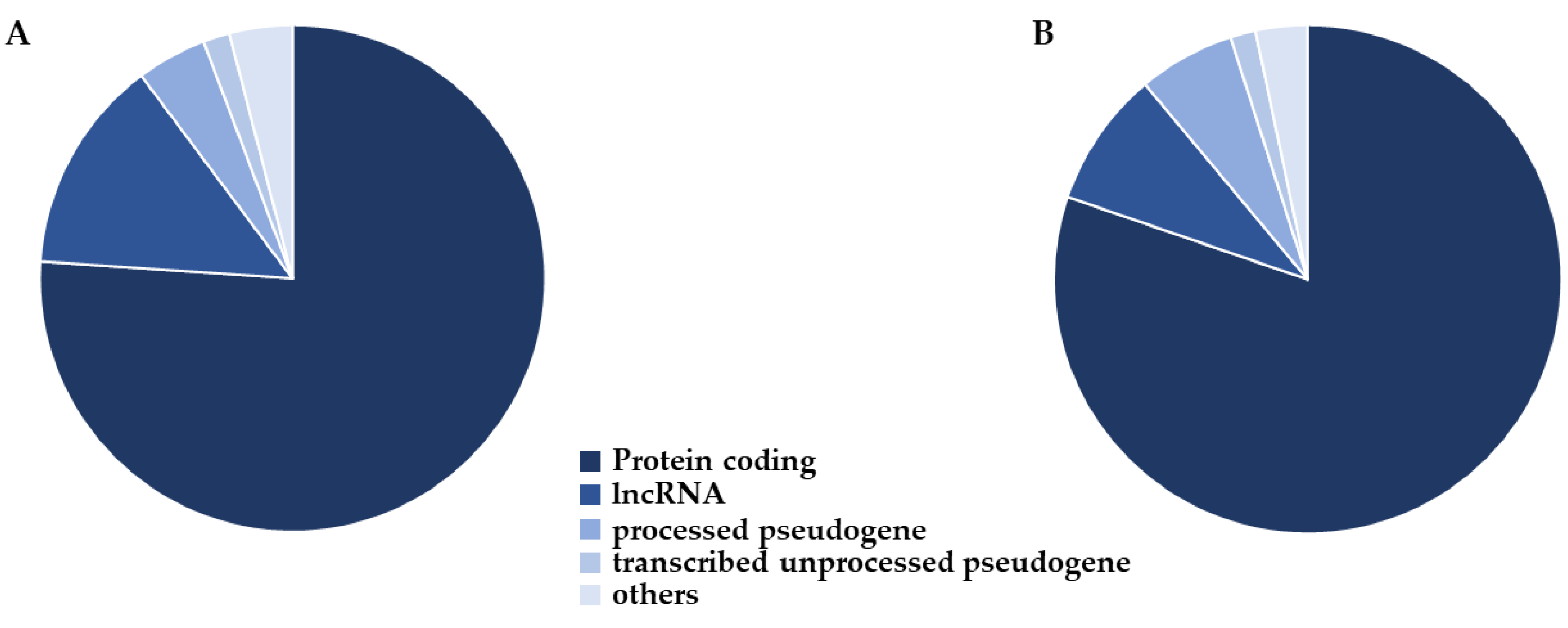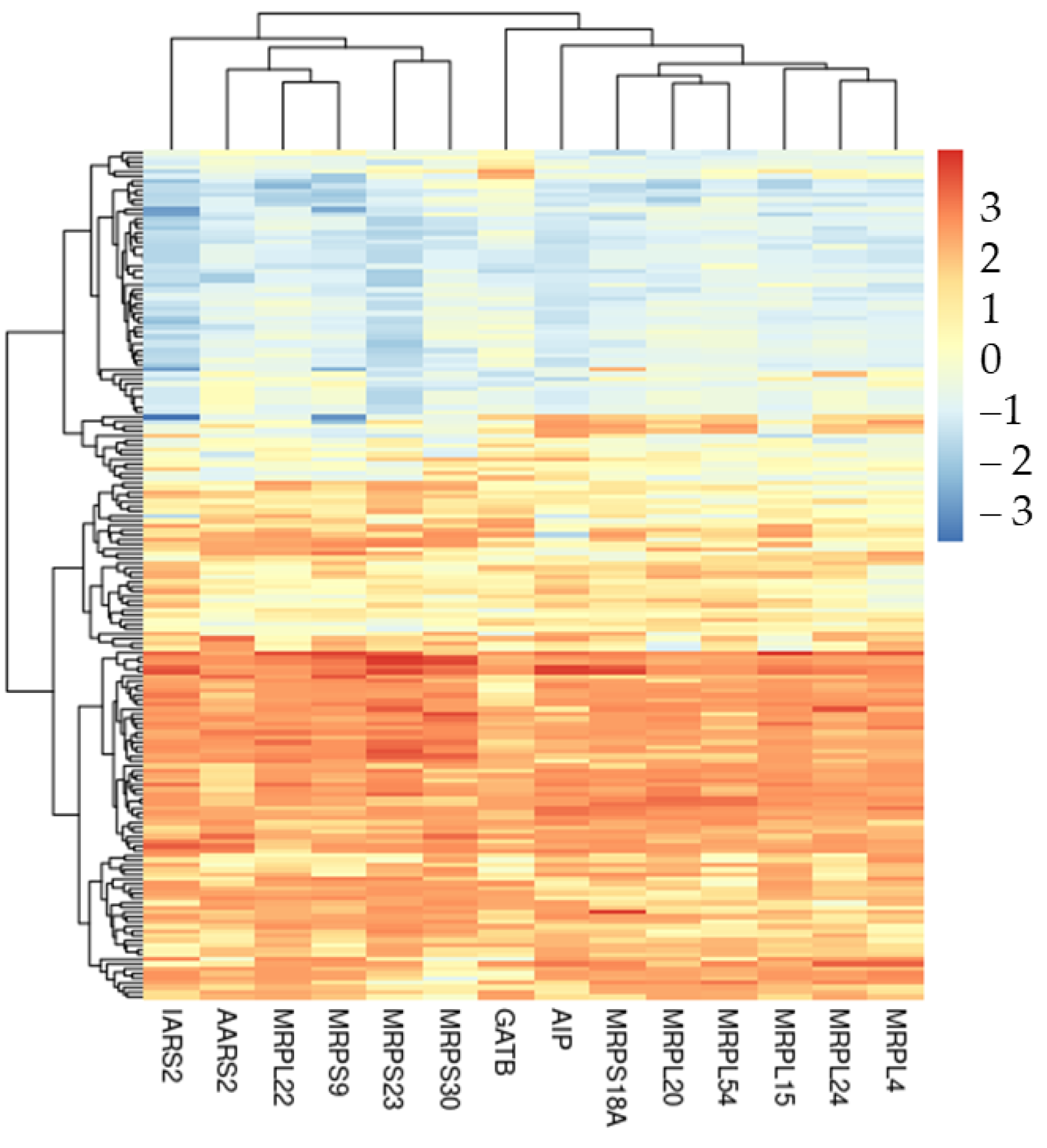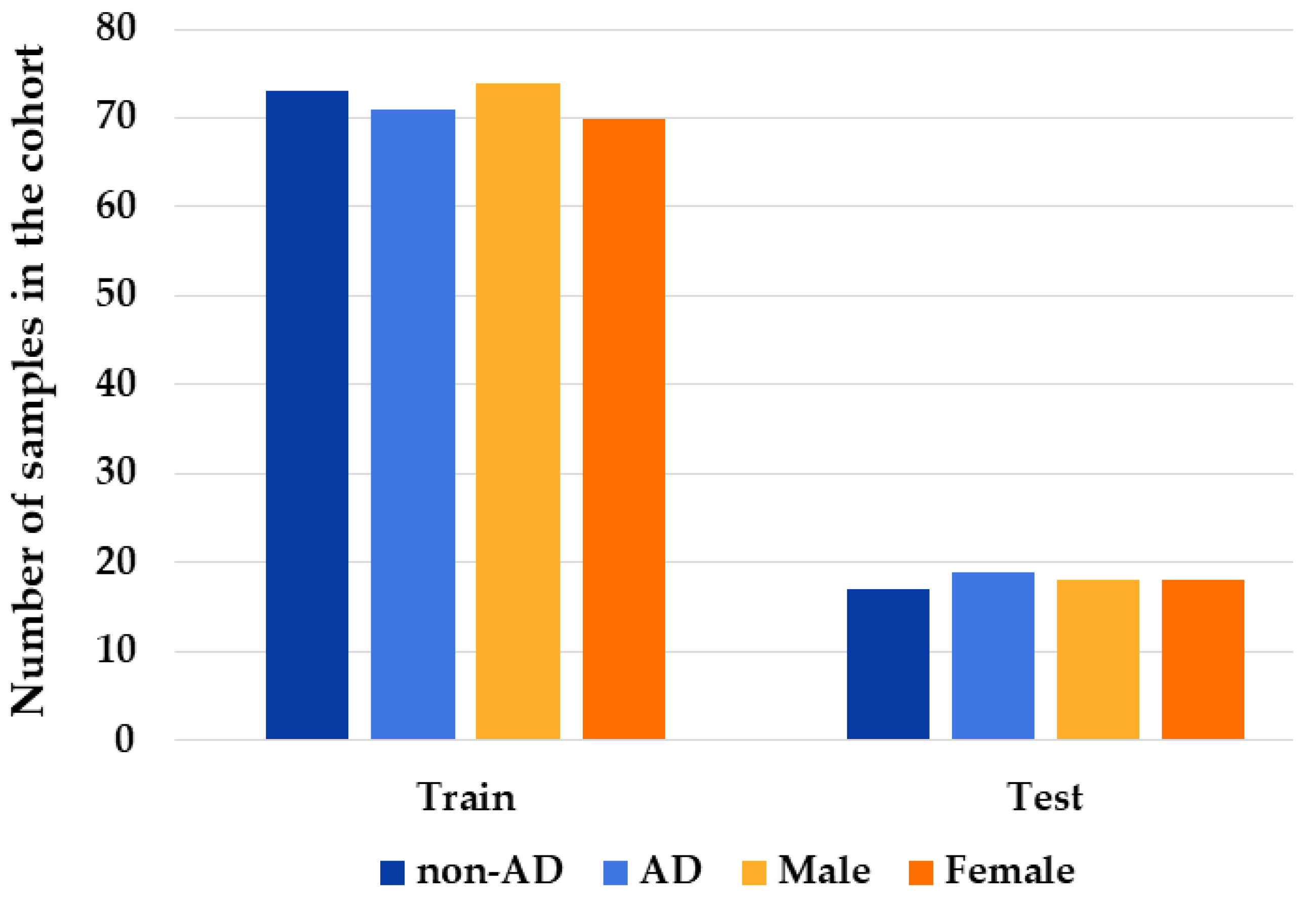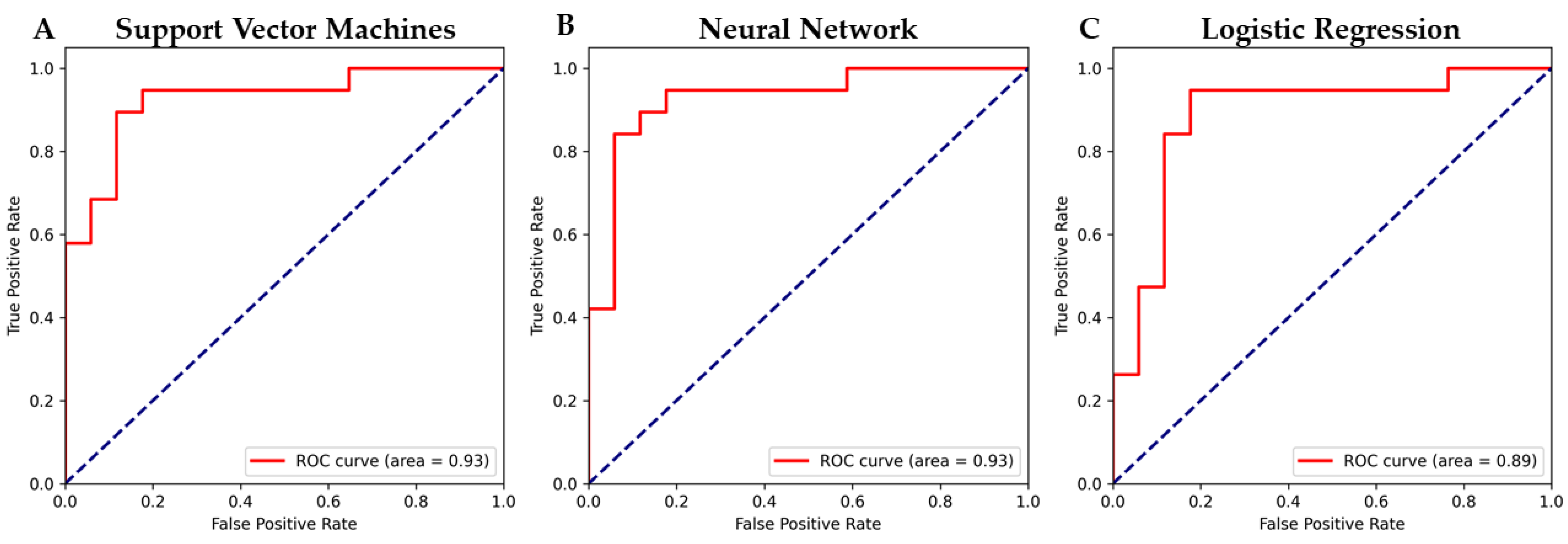Artificial Intelligence Predictor for Alzheimer’s Disease Trained on Blood Transcriptome: The Role of Oxidative Stress
Abstract
:1. Introduction
2. Results
2.1. Selected Features
2.2. DEGs
2.3. Differentially Expressed Features
2.4. Training and Test Sets
2.5. Model Evaluation
3. Discussion
4. Materials and Methods
4.1. Microarray Dataset Selection
4.2. Sample Preparation
4.3. Matrix Reconstruction and DEG Analysis
4.4. Feature Selection and Normalization
4.5. Feature and DEG Enrichment
4.6. Model Construction and Hyperparameter Tuning
5. Conclusions
Supplementary Materials
Author Contributions
Funding
Institutional Review Board Statement
Informed Consent Statement
Data Availability Statement
Conflicts of Interest
References
- Goate, A.; Chartier-Harlin, M.C.; Mullan, M.; Brown, J.; Crawford, F.; Fidani, L.; Giuffra, L.; Haynes, A.; Irving, N.; James, L.; et al. Segregation of a missense mutation in the amyloid precursor protein gene with familial Alzheimer’s disease. Nature 1991, 349, 704–706. [Google Scholar] [CrossRef] [PubMed]
- Sherrington, R.; Rogaev, E.I.; Liang, Y.; Rogaeva, E.A.; Levesque, G.; Ikeda, M.; Chi, H.; Lin, C.; Li, G.; Holman, K.; et al. Cloning of a gene bearing missense mutations in early-onset familial Alzheimer’s disease. Nature 1995, 375, 754–760. [Google Scholar] [CrossRef] [PubMed]
- Giau, V.V.; Pyun, J.M.; Bagyinszky, E.; An, S.S.A.; Kim, S. A pathogenic PSEN2 p.His169Asn mutation associated with early-onset Alzheimer’s disease. Clin. Interv. Aging 2018, 13, 1321–1329. [Google Scholar] [CrossRef] [PubMed] [Green Version]
- Zhu, X.C.; Tan, L.; Wang, H.F.; Jiang, T.; Cao, L.; Wang, C.; Wang, J.; Tan, C.C.; Meng, X.F.; Yu, J.T. Rate of early onset Alzheimer’s disease: A systematic review and meta-analysis. Ann. Transl. Med. 2015, 3, 38. [Google Scholar] [CrossRef]
- Klunk, W.E.; Engler, H.; Nordberg, A.; Wang, Y.; Blomqvist, G.; Holt, D.P.; Bergstrom, M.; Savitcheva, I.; Huang, G.F.; Estrada, S.; et al. Imaging brain amyloid in Alzheimer’s disease with Pittsburgh Compound-B. Ann. Neurol. 2004, 55, 306–319. [Google Scholar] [CrossRef] [PubMed]
- Knopman, D.S.; Jack, C.R., Jr.; Lundt, E.S.; Weigand, S.D.; Vemuri, P.; Lowe, V.J.; Kantarci, K.; Gunter, J.L.; Senjem, M.L.; Mielke, M.M.; et al. Evolution of neurodegeneration-imaging biomarkers from clinically normal to dementia in the Alzheimer disease spectrum. Neurobiol. Aging 2016, 46, 32–42. [Google Scholar] [CrossRef] [PubMed] [Green Version]
- Kulichikhin, K.Y.; Fedotov, S.A.; Rubel, M.S.; Zalutskaya, N.M.; Zobnina, A.E.; Malikova, O.A.; Neznanov, N.G.; Chernoff, Y.O.; Rubel, A.A. Development of molecular tools for diagnosis of Alzheimer’s disease that are based on detection of amyloidogenic proteins. Prion 2021, 15, 56–69. [Google Scholar] [CrossRef]
- Sancesario, G.M.; Bernardini, S. Alzheimer’s disease in the omics era. Clin. Biochem. 2018, 59, 9–16. [Google Scholar] [CrossRef]
- Chen, G.; Yin, K.; Shi, L.; Fang, Y.; Qi, Y.; Li, P.; Luo, J.; He, B.; Liu, M.; Shi, T. Comparative analysis of human protein-coding and noncoding RNAs between brain and 10 mixed cell lines by RNA-Seq. PLoS ONE 2011, 6, e28318. [Google Scholar] [CrossRef] [PubMed] [Green Version]
- Idda, M.L.; Munk, R.; Abdelmohsen, K.; Gorospe, M. Noncoding RNAs in Alzheimer’s disease. Wiley Interdiscip. Rev. RNA 2018, 9, e1463. [Google Scholar] [CrossRef] [PubMed]
- Gugliandolo, A.; Chiricosta, L.; Boccardi, V.; Mecocci, P.; Bramanti, P.; Mazzon, E. MicroRNAs Modulate the Pathogenesis of Alzheimer’s Disease: An In Silico Analysis in the Human Brain. Genes 2020, 11, 983. [Google Scholar] [CrossRef]
- Li, J.; Liu, C. Coding or Noncoding, the Converging Concepts of RNAs. Front. Genet. 2019, 10, 496. [Google Scholar] [CrossRef] [PubMed]
- Su, C.; Tong, J.; Wang, F. Mining genetic and transcriptomic data using machine learning approaches in Parkinson’s disease. NPJ Parkinson’s Dis. 2020, 6, 24. [Google Scholar] [CrossRef] [PubMed]
- Arjmand, B.; Hamidpour, S.K.; Tayanloo-Beik, A.; Goodarzi, P.; Aghayan, H.R.; Adibi, H.; Larijani, B. Machine Learning: A New Prospect in Multi-Omics Data Analysis of Cancer. Front. Genet. 2022, 13, 824451. [Google Scholar] [CrossRef]
- Tran, K.A.; Kondrashova, O.; Bradley, A.; Williams, E.D.; Pearson, J.V.; Waddell, N. Deep learning in cancer diagnosis, prognosis and treatment selection. Genome Med. 2021, 13, 152. [Google Scholar] [CrossRef] [PubMed]
- Garcia-Fonseca, A.; Martin-Jimenez, C.; Barreto, G.E.; Pachon, A.F.A.; Gonzalez, J. The Emerging Role of Long Non-Coding RNAs and MicroRNAs in Neurodegenerative Diseases: A Perspective of Machine Learning. Biomolecules 2021, 11, 1132. [Google Scholar] [CrossRef] [PubMed]
- Ahmed, M.R.; Zhang, Y.; Feng, Z.; Lo, B.; Inan, O.T.; Liao, H. Neuroimaging and Machine Learning for Dementia Diagnosis: Recent Advancements and Future Prospects. IEEE Rev. Biomed. Eng. 2019, 12, 19–33. [Google Scholar] [CrossRef]
- Huang, Y.; Sun, X.; Jiang, H.; Yu, S.; Robins, C.; Armstrong, M.J.; Li, R.; Mei, Z.; Shi, X.; Gerasimov, E.S.; et al. A machine learning approach to brain epigenetic analysis reveals kinases associated with Alzheimer’s disease. Nat. Commun. 2021, 12, 4472. [Google Scholar] [CrossRef]
- Leidinger, P.; Backes, C.; Deutscher, S.; Schmitt, K.; Mueller, S.C.; Frese, K.; Haas, J.; Ruprecht, K.; Paul, F.; Stahler, C.; et al. A blood based 12-miRNA signature of Alzheimer disease patients. Genome Biol. 2013, 14, R78. [Google Scholar] [CrossRef] [PubMed] [Green Version]
- Yuen, S.C.; Liang, X.; Zhu, H.; Jia, Y.; Leung, S.W. Prediction of differentially expressed microRNAs in blood as potential biomarkers for Alzheimer’s disease by meta-analysis and adaptive boosting ensemble learning. Alzheimer’s Res. Ther. 2021, 13, 126. [Google Scholar] [CrossRef]
- Xu, A.; Kouznetsova, V.L.; Tsigelny, I.F. Alzheimer’s Disease Diagnostics Using miRNA Biomarkers and Machine Learning. J. Alzheimer’s Dis. JAD 2022, 86, 841–859. [Google Scholar] [CrossRef]
- Knopman, D.S.; Amieva, H.; Petersen, R.C.; Chetelat, G.; Holtzman, D.M.; Hyman, B.T.; Nixon, R.A.; Jones, D.T. Alzheimer disease. Nat. Rev. Dis. Primers 2021, 7, 33. [Google Scholar] [CrossRef]
- Shaw, L.M.; Arias, J.; Blennow, K.; Galasko, D.; Molinuevo, J.L.; Salloway, S.; Schindler, S.; Carrillo, M.C.; Hendrix, J.A.; Ross, A.; et al. Appropriate use criteria for lumbar puncture and cerebrospinal fluid testing in the diagnosis of Alzheimer’s disease. Alzheimer’s Dement. J. Alzheimer’s Assoc. 2018, 14, 1505–1521. [Google Scholar] [CrossRef] [PubMed]
- Ashton, N.J.; Hye, A.; Rajkumar, A.P.; Leuzy, A.; Snowden, S.; Suarez-Calvet, M.; Karikari, T.K.; Scholl, M.; La Joie, R.; Rabinovici, G.D.; et al. An update on blood-based biomarkers for non-Alzheimer neurodegenerative disorders. Nat. Rev. Neurol. 2020, 16, 265–284. [Google Scholar] [CrossRef]
- Greber, B.J.; Ban, N. Structure and Function of the Mitochondrial Ribosome. Annu. Rev. Biochem. 2016, 85, 103–132. [Google Scholar] [CrossRef] [PubMed]
- Goncalves, A.M.; Pereira-Santos, A.R.; Esteves, A.R.; Cardoso, S.M.; Empadinhas, N. The Mitochondrial Ribosome: A World of Opportunities for Mitochondrial Dysfunction Toward Parkinson’s Disease. Antioxid. Redox Signal. 2021, 34, 694–711. [Google Scholar] [CrossRef]
- Sylvester, J.E.; Fischel-Ghodsian, N.; Mougey, E.B.; O’Brien, T.W. Mitochondrial ribosomal proteins: Candidate genes for mitochondrial disease. Genet. Med. Off. J. Am. Coll. Med. Genet. 2004, 6, 73–80. [Google Scholar] [CrossRef] [PubMed] [Green Version]
- Volgyi, K.; Badics, K.; Sialana, F.J.; Gulyassy, P.; Udvari, E.B.; Kis, V.; Drahos, L.; Lubec, G.; Kekesi, K.A.; Juhasz, G. Early Presymptomatic Changes in the Proteome of Mitochondria-Associated Membrane in the APP/PS1 Mouse Model of Alzheimer’s Disease. Mol. Neurobiol. 2018, 55, 7839–7857. [Google Scholar] [CrossRef]
- Sorrentino, V.; Romani, M.; Mouchiroud, L.; Beck, J.S.; Zhang, H.; D’Amico, D.; Moullan, N.; Potenza, F.; Schmid, A.W.; Rietsch, S.; et al. Enhancing mitochondrial proteostasis reduces amyloid-beta proteotoxicity. Nature 2017, 552, 187–193. [Google Scholar] [CrossRef]
- Yano, M.; Terada, K.; Mori, M. AIP is a mitochondrial import mediator that binds to both import receptor Tom20 and preproteins. J. Cell Biol. 2003, 163, 45–56. [Google Scholar] [CrossRef]
- Shringarpure, R.; Grune, T.; Davies, K.J. Protein oxidation and 20S proteasome-dependent proteolysis in mammalian cells. Cell. Mol. Life Sci. CMLS 2001, 58, 1442–1450. [Google Scholar] [CrossRef]
- Hong, L.; Huang, H.C.; Jiang, Z.F. Relationship between amyloid-beta and the ubiquitin-proteasome system in Alzheimer’s disease. Neurol. Res. 2014, 36, 276–282. [Google Scholar] [CrossRef]
- Hansson Petersen, C.A.; Alikhani, N.; Behbahani, H.; Wiehager, B.; Pavlov, P.F.; Alafuzoff, I.; Leinonen, V.; Ito, A.; Winblad, B.; Glaser, E.; et al. The amyloid beta-peptide is imported into mitochondria via the TOM import machinery and localized to mitochondrial cristae. Proc. Natl. Acad. Sci. USA 2008, 105, 13145–13150. [Google Scholar] [CrossRef] [Green Version]
- Sirk, D.; Zhu, Z.; Wadia, J.S.; Shulyakova, N.; Phan, N.; Fong, J.; Mills, L.R. Chronic exposure to sub-lethal beta-amyloid (Abeta) inhibits the import of nuclear-encoded proteins to mitochondria in differentiated PC12 cells. J. Neurochem. 2007, 103, 1989–2003. [Google Scholar] [CrossRef]
- Bonet-Costa, V.; Pomatto, L.C.; Davies, K.J. The Proteasome and Oxidative Stress in Alzheimer’s Disease. Antioxid. Redox Signal. 2016, 25, 886–901. [Google Scholar] [CrossRef] [Green Version]
- Hadrava Vanova, K.; Kraus, M.; Neuzil, J.; Rohlena, J. Mitochondrial complex II and reactive oxygen species in disease and therapy. Redox Rep. Commun. Free. Radic. Res. 2020, 25, 26–32. [Google Scholar] [CrossRef] [Green Version]
- Holper, L.; Ben-Shachar, D.; Mann, J.J. Multivariate meta-analyses of mitochondrial complex I and IV in major depressive disorder, bipolar disorder, schizophrenia, Alzheimer disease, and Parkinson disease. Neuropsychopharmacol. Off. Publ. Am. Coll. Neuropsychopharmacol. 2019, 44, 837–849. [Google Scholar] [CrossRef]
- Uddin, M.S.; Tewari, D.; Sharma, G.; Kabir, M.T.; Barreto, G.E.; Bin-Jumah, M.N.; Perveen, A.; Abdel-Daim, M.M.; Ashraf, G.M. Molecular Mechanisms of ER Stress and UPR in the Pathogenesis of Alzheimer’s Disease. Mol. Neurobiol. 2020, 57, 2902–2919. [Google Scholar] [CrossRef]
- Lin, J.H.; Walter, P.; Yen, T.S. Endoplasmic reticulum stress in disease pathogenesis. Annu. Rev. Pathol. 2008, 3, 399–425. [Google Scholar] [CrossRef]
- Ferreiro, E.; Baldeiras, I.; Ferreira, I.L.; Costa, R.O.; Rego, A.C.; Pereira, C.F.; Oliveira, C.R. Mitochondrial- and endoplasmic reticulum-associated oxidative stress in Alzheimer’s disease: From pathogenesis to biomarkers. Int. J. Cell Biol. 2012, 2012, 735206. [Google Scholar] [CrossRef]
- Castellani, R.; Hirai, K.; Aliev, G.; Drew, K.L.; Nunomura, A.; Takeda, A.; Cash, A.D.; Obrenovich, M.E.; Perry, G.; Smith, M.A. Role of mitochondrial dysfunction in Alzheimer’s disease. J. Neurosci. Res. 2002, 70, 357–360. [Google Scholar] [CrossRef] [PubMed]
- Gibson, G.E.; Sheu, K.F.; Blass, J.P. Abnormalities of mitochondrial enzymes in Alzheimer disease. J. Neural Transm. 1998, 105, 855–870. [Google Scholar] [CrossRef] [PubMed]
- Wang, X.; Wang, W.; Li, L.; Perry, G.; Lee, H.G.; Zhu, X. Oxidative stress and mitochondrial dysfunction in Alzheimer’s disease. Biochim. Et Biophys. Acta 2014, 1842, 1240–1247. [Google Scholar] [CrossRef] [Green Version]
- Barrett, T.; Wilhite, S.E.; Ledoux, P.; Evangelista, C.; Kim, I.F.; Tomashevsky, M.; Marshall, K.A.; Phillippy, K.H.; Sherman, P.M.; Holko, M.; et al. NCBI GEO: Archive for functional genomics data sets--update. Nucleic Acids Res. 2013, 41, D991–D995. [Google Scholar] [CrossRef] [Green Version]
- Ritchie, M.E.; Phipson, B.; Wu, D.; Hu, Y.; Law, C.W.; Shi, W.; Smyth, G.K. limma powers differential expression analyses for RNA-sequencing and microarray studies. Nucleic Acids Res. 2015, 43, e47. [Google Scholar] [CrossRef]
- Gentleman, R.C.; Carey, V.J.; Bates, D.M.; Bolstad, B.; Dettling, M.; Dudoit, S.; Ellis, B.; Gautier, L.; Ge, Y.; Gentry, J.; et al. Bioconductor: Open software development for computational biology and bioinformatics. Genome Biol. 2004, 5, R80. [Google Scholar] [CrossRef] [Green Version]
- Rao, Y.; Lee, Y.; Jarjoura, D.; Ruppert, A.S.; Liu, C.G.; Hsu, J.C.; Hagan, J.P. A comparison of normalization techniques for microRNA microarray data. Stat. Appl. Genet. Mol. Biol. 2008, 7, 22. [Google Scholar] [CrossRef]
- Durinck, S.; Moreau, Y.; Kasprzyk, A.; Davis, S.; De Moor, B.; Brazma, A.; Huber, W. BioMart and Bioconductor: A powerful link between biological databases and microarray data analysis. Bioinformatics 2005, 21, 3439–3440. [Google Scholar] [CrossRef] [Green Version]
- Howe, K.L.; Achuthan, P.; Allen, J.; Allen, J.; Alvarez-Jarreta, J.; Amode, M.R.; Armean, I.M.; Azov, A.G.; Bennett, R.; Bhai, J.; et al. Ensembl 2021. Nucleic Acids Res. 2021, 49, D884–D891. [Google Scholar] [CrossRef]
- Harris, C.R.; Millman, K.J.; van der Walt, S.J.; Gommers, R.; Virtanen, P.; Cournapeau, D.; Wieser, E.; Taylor, J.; Berg, S.; Smith, N.J.; et al. Array programming with NumPy. Nature 2020, 585, 357–362. [Google Scholar] [CrossRef]
- Virtanen, P.; Gommers, R.; Oliphant, T.E.; Haberland, M.; Reddy, T.; Cournapeau, D.; Burovski, E.; Peterson, P.; Weckesser, W.; Bright, J.; et al. SciPy 1.0: Fundamental algorithms for scientific computing in Python. Nat. Methods 2020, 17, 261–272. [Google Scholar] [CrossRef] [PubMed] [Green Version]
- Mi, H.; Ebert, D.; Muruganujan, A.; Mills, C.; Albou, L.P.; Mushayamaha, T.; Thomas, P.D. PANTHER version 16: A revised family classification, tree-based classification tool, enhancer regions and extensive API. Nucleic Acids Res. 2021, 49, D394–D403. [Google Scholar] [CrossRef]
- Kanehisa, M.; Goto, S. KEGG: Kyoto encyclopedia of genes and genomes. Nucleic Acids Res. 2000, 28, 27–30. [Google Scholar] [CrossRef] [PubMed]





| Gene Ontology ID | Gene Ontology Description | Genes | Fold Enrichment | False Discovery Rate |
|---|---|---|---|---|
| GO:0032543 | mitochondrial translation | 19 | 3.86 | 2.02 × 10−2 |
| GO:0140053 | mitochondrial gene expression | 21 | 3.31 | 3.46 × 10−2 |
| GO:0044237 | cellular metabolic process | 392 | 1.20 | 4.65 × 10−2 |
| GO:0009987 | cellular process | 777 | 1.12 | 2.65 × 10−6 |
| Gene Ontology ID | Gene Ontology Description | Genes | Fold Enrichment | False Discovery Rate |
|---|---|---|---|---|
| GO:0070129 | regulation of mitochondrial translation | 17 | 3.39 | 2.39 × 10−2 |
| GO:0062125 | regulation of mitochondrial gene expression | 18 | 3.10 | 4.78 × 10−2 |
| GO:0000154 | rRNA modification | 21 | 2.83 | 3.08 × 10−2 |
| GO:0000387 | spliceosomal snRNP assembly | 21 | 2.76 | 3.75 × 10−2 |
| GO:0140053 | mitochondrial gene expression | 76 | 2.73 | 1.58 × 10−8 |
| GO:0032543 | mitochondrial translation | 59 | 2.73 | 1.39 × 10−6 |
| GO:0006476 | protein deacetylation | 30 | 2.46 | 2.03 × 10−2 |
| GO:0016575 | histone deacetylation | 28 | 2.41 | 3.78 × 10−2 |
| GO:0001510 | RNA methylation | 43 | 2.33 | 1.93 × 10−3 |
| GO:0042273 | ribosomal large subunit biogenesis | 33 | 2.29 | 2.10 × 10−2 |
| Gene Ontology ID | Gene Ontology Description | Genes | Fold Enrichment | False Discovery Rate |
|---|---|---|---|---|
| GO:0032543 | mitochondrial translation | 14 | 7.20 | 6.25 × 10−5 |
| GO:0140053 | mitochondrial gene expression | 16 | 5.97 | 1.36 × 10−4 |
| GO:0008380 | RNA splicing | 23 | 3.32 | 9.90 × 10−4 |
| GO:0006412 | translation | 23 | 3.16 | 1.78 × 10−3 |
| GO:0043043 | peptide biosynthetic process | 24 | 3.08 | 1.83 × 10−3 |
| GO:0006397 | mRNA processing | 26 | 3.06 | 8.87 × 10−4 |
| GO:0016071 | mRNA metabolic process | 35 | 3.04 | 6.37 × 10−5 |
| GO:0006518 | peptide metabolic process | 28 | 2.70 | 2.65 × 10−3 |
| GO:0006396 | RNA processing | 39 | 2.36 | 1.38 × 10−3 |
| GO:0043603 | cellular amide metabolic process | 35 | 2.26 | 7.80 × 10−3 |
| Gene | Non-AD Mean Expression | AD Mean Expression | Fold Change | q-Value |
|---|---|---|---|---|
| MRPL54 | 0.56 | 1.14 | 0.58 | 1.82 × 10−2 |
| MRPS23 | 0.29 | 1.35 | 1.06 | 2.01 × 10−3 |
| MRPL22 | 0.45 | 1.33 | 0.88 | 1.99 × 10−3 |
| MRPS18A | 0.58 | 1.28 | 0.70 | 1.20 × 10−2 |
| MRPL24 | 0.40 | 1.16 | 0.75 | 4.19 × 10−3 |
| MRPS9 | 0.33 | 1.19 | 0.86 | 4.52 × 10−3 |
| MRPS30 | 0.38 | 1.44 | 1.05 | 3.68 × 10−4 |
| AARS2 | 0.33 | 1.21 | 0.88 | 1.27 × 10−3 |
| IARS2 | 0.34 | 1.02 | 0.68 | 4.30 × 10−2 |
| AIP | 0.50 | 1.17 | 0.66 | 2.65 × 10−2 |
| GATB | 0.48 | 1.20 | 0.72 | 2.02 × 10−3 |
| MRPL15 | 0.49 | 1.23 | 0.74 | 7.25 × 10−3 |
| MRPL20 | 0.57 | 1.13 | 0.56 | 3.85 × 10−2 |
| MRPL4 | 0.34 | 1.25 | 0.91 | 1.28 × 10−3 |
| Model | ROC | Accuracy | F1 | MCC | Precision | Recall |
|---|---|---|---|---|---|---|
| Support Vector Machines | 0.93 | 0.89 | 0.90 | 0.78 | 0.86 | 0.95 |
| Neural Network | 0.93 | 0.86 | 0.87 | 0.72 | 0.85 | 0.90 |
| Logistic Regression | 0.89 | 0.89 | 0.90 | 0.78 | 0.86 | 0.95 |
Publisher’s Note: MDPI stays neutral with regard to jurisdictional claims in published maps and institutional affiliations. |
© 2022 by the authors. Licensee MDPI, Basel, Switzerland. This article is an open access article distributed under the terms and conditions of the Creative Commons Attribution (CC BY) license (https://creativecommons.org/licenses/by/4.0/).
Share and Cite
Chiricosta, L.; D’Angiolini, S.; Gugliandolo, A.; Mazzon, E. Artificial Intelligence Predictor for Alzheimer’s Disease Trained on Blood Transcriptome: The Role of Oxidative Stress. Int. J. Mol. Sci. 2022, 23, 5237. https://doi.org/10.3390/ijms23095237
Chiricosta L, D’Angiolini S, Gugliandolo A, Mazzon E. Artificial Intelligence Predictor for Alzheimer’s Disease Trained on Blood Transcriptome: The Role of Oxidative Stress. International Journal of Molecular Sciences. 2022; 23(9):5237. https://doi.org/10.3390/ijms23095237
Chicago/Turabian StyleChiricosta, Luigi, Simone D’Angiolini, Agnese Gugliandolo, and Emanuela Mazzon. 2022. "Artificial Intelligence Predictor for Alzheimer’s Disease Trained on Blood Transcriptome: The Role of Oxidative Stress" International Journal of Molecular Sciences 23, no. 9: 5237. https://doi.org/10.3390/ijms23095237
APA StyleChiricosta, L., D’Angiolini, S., Gugliandolo, A., & Mazzon, E. (2022). Artificial Intelligence Predictor for Alzheimer’s Disease Trained on Blood Transcriptome: The Role of Oxidative Stress. International Journal of Molecular Sciences, 23(9), 5237. https://doi.org/10.3390/ijms23095237






